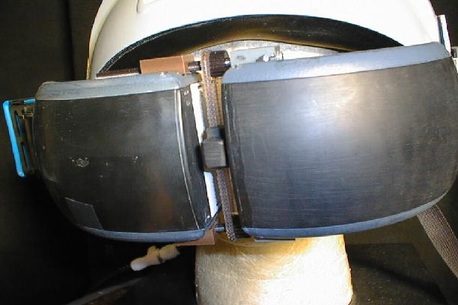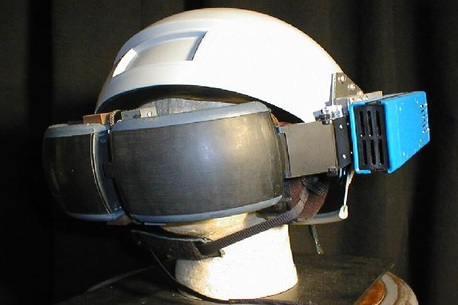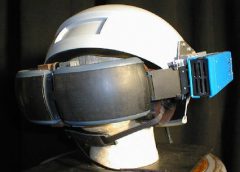
About: The system creates a very wide field of view display both horizontally and vertically by tiling six displays per eye to give the wide F.O.V. and maintain a high resolution image around. Electronics for the displays extend along the ear pieces on the side of the helmet and distribute the 800 x 600 resolution image into the individual displays. An optical system utilizing a meniscus mirror and passive filters by Kaiser keeps the unit compact.
Tracking of the headset is accomplished by UNC-CH designed “HiBall” ceiling tracker or a commercially available magnetic tracker. Either of which has a calibrated mount on the back of the headset. HMD mounts and integration by the Microelectronics Systems Laboratory at UNC.
Kaiser Display Specs and Info…
Device: Kaiser Display
Manufacturer: Kaiser Electro-Optics, Inc
Announced Date: April 2006
Release Date: Unknown
Launch Price: Unknown
Device Type: VR Headset (PC Powered)
Display: 6X 0.7″ active matrix at 800 x 600 (Per Eye)
Diagonal Field of View(FOV): 150°
Refresh Rate: 30 Hz
Weight: 1587 g (3.5 lb)
CPU: N/A
GPU: N/A
Battery: N/A
Tracking: 3 DoF Non-positional (Via “HiBall” ceiling tracker)
Controllers: N/A

Our Thoughts: If this flight helmet looking VR headset called the Kaiser Display is just a University build why are we including it here? Because of the tech. You might have noticed that here at the VR shop we don’t go into too much detail about the apps and games you might be able to play with these headsets because we enjoy the technology of VR.
We decided to include the Kaiser Display because at some point it will probably influence someone within the VR industry to build a better headset, to at least conceive that it can be done right this time. It also shows that VR never went anywhere! People say it was a failure in the 90’s but that is simply not true. It just hide in University cupboards and NASA cloakrooms waiting for someone to realise that it was ready to be born again. Sure, it’s not a very good headset even for the tech at the time, but it’s a headset that does deserve a little respect for holding up the VR flag and waving it even if no one was listening.
Sources used…
- https://www.cs.unc.edu/~keller/kaiser/kaiser.html

Kaiser Electro Optical made a number of HMDs during the 90 and early 2000s. You can find a number of them on this web page… http://www.stereo3d.com/hmd.htm
I had use of one of their ProView systems at one of my jobs and it was the nicest HMD of the era… one of the few that was not a hand-held hmd, requiring you to regularly hold it in place.
I reviewed the VR industry in late 90s for VRNews, writing their Technology Review column.